The Spray Painting Machine Market is estimated to be valued at USD 4.8 billion in 2025 and is projected to reach USD 7.7 billion by 2035, registering a compound annual growth rate (CAGR) of 4.9% over the forecast period.
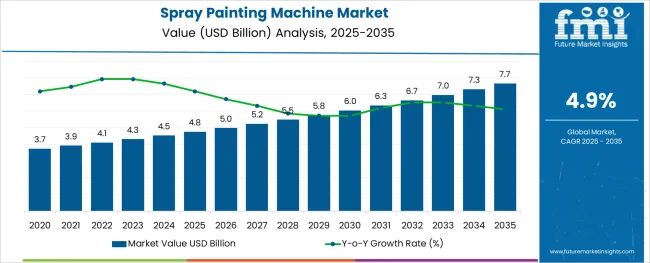
The spray painting machine market is undergoing steady growth as advancements in manufacturing, rising demand for superior surface finishes, and stringent quality standards reshape the dynamics of industrial and commercial painting processes. The shift towards automated, precise, and efficient painting solutions is being driven by the need to reduce material wastage, ensure uniform coatings, and improve workplace safety.
Manufacturers are focusing on integrating ergonomic designs, digital controls, and energy-efficient systems to enhance productivity while addressing environmental concerns. Future growth is expected to be supported by the adoption of smart manufacturing technologies, increasing investments in infrastructure and automotive sectors, and heightened emphasis on sustainability and compliance with emission norms.
Innovations in nozzle technology, lightweight materials, and user-friendly interfaces are paving the way for broader acceptance across diverse industries, reinforcing the market’s trajectory towards higher operational efficiency and quality standards.
The market is segmented by Type and Application and region. By Type, the market is divided into Airless spraying machines, HVLP spraying machines, and LVLP spraying. In terms of Application, the market is classified into Automotive Industry, Wood Furniture Industry, Aerospace Industry, Construction Industry, Food & Beverage Equipment Manufacturing Industry, and Others. Regionally, the market is classified into North America, Latin America, Western Europe, Eastern Europe, Balkan & Baltic Countries, Russia & Belarus, Central Asia, East Asia, South Asia & Pacific, and the Middle East & Africa.
The market is segmented by Type and Application and region. By Type, the market is divided into Airless spraying machines, HVLP spraying machines, and LVLP spraying. In terms of Application, the market is classified into Automotive Industry, Wood Furniture Industry, Aerospace Industry, Construction Industry, Food & Beverage Equipment Manufacturing Industry, and Others. Regionally, the market is classified into North America, Latin America, Western Europe, Eastern Europe, Balkan & Baltic Countries, Russia & Belarus, Central Asia, East Asia, South Asia & Pacific, and the Middle East & Africa.
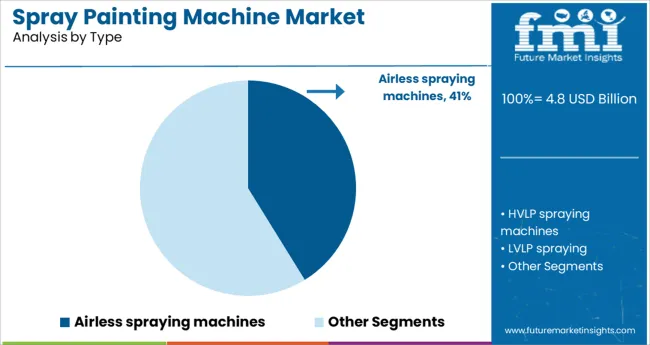
When segmented by type, airless spraying machines are projected to hold 41.2 % of the total market revenue in 2025, making them the leading type segment. This dominance is attributed to the ability of airless machines to deliver high-speed, uniform coatings with minimal overspray, which significantly enhances productivity and reduces material consumption.
Their capability to handle high-viscosity coatings without dilution has positioned them as a preferred choice for demanding industrial and commercial applications. The robust construction and simplicity of operation have allowed these machines to perform reliably in large-scale projects where efficiency and coverage are critical.
Improvements in pump technology and pressure regulation have further increased their appeal by providing consistent finishes and reducing maintenance requirements. These factors have collectively reinforced the leadership of airless spraying machines in the market, particularly in scenarios where speed, quality, and cost-effectiveness are prioritized.
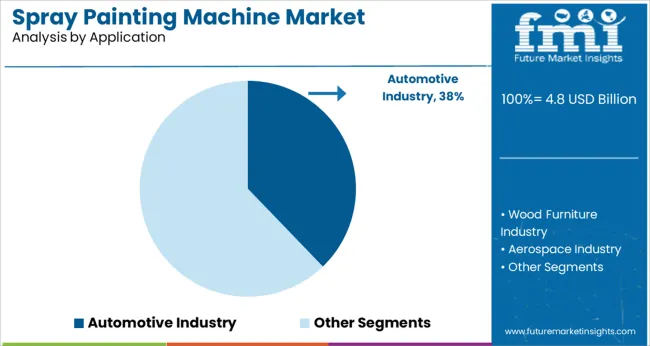
Segmented by application, the automotive industry is expected to account for 37.8 % of the spray painting machine market revenue in 2025, maintaining its position as the top application segment. This leadership is driven by the automotive sector’s stringent requirements for high-quality surface finishes, corrosion resistance, and consistent color matching across components.
The need for efficient, automated solutions capable of meeting tight production timelines and complex geometries has propelled the adoption of advanced spraying machines in manufacturing and repair facilities. The integration of programmable controls and precision nozzles has enabled manufacturers to achieve superior results while minimizing paint wastage and meeting environmental compliance.
As vehicle designs evolve and consumer expectations for flawless finishes rise, the automotive industry continues to invest in state-of-the-art spraying technologies. This sustained focus on quality, efficiency, and sustainability has solidified the automotive segment’s leading share in the market.
The global Spray Painting Machine market was valued at USD 4,325.4 million in 2025 and will reach USD 6,978.9 million by the end of 2035, growing at a CAGR of 4.9% from 2025 to 2035.
A spray painting machine is a device that uses a compressed air system to atomize and deliver paint to a surface. The machine typically has a reservoir for paint, a compressor to generate the air pressure, and a nozzle through which the paint is sprayed.
Spray painting machines are used in a variety of applications, including automotive and industrial painting, powder coating, and general-purpose spraying. Automotive applications typically use electrostatic spray guns, which provide a more uniform paint finish. Industrial applications may use either electrostatic or air-assisted airless spray guns.
The global spray painting machine market is forecast to reach USD 3,248.1 million by 2020, according to a previous report by FMI. The market was valued at USD 4,123.8 million in 2025 and is expected to grow at a CAGR of 4.9% during the forecast period.
The historical outlook for the spray painting machine market indicates that the market has shown steady growth in the past couple of years and is expected to continue on this growth trajectory in the coming years as well. The future projections for the global spray painting machine market are positive and indicate that the market will continue to grow at a healthy pace in the next few years.
Airless spray painting machines provide a faster, more efficient way to paint than traditional methods. They can be used for a variety of projects, both large and small. Here are some benefits of using an airless spray painting machine:
In the food and beverage manufacturing industry, there are many different types of machinery and equipment that are used in production. One of the most important pieces of equipment is the spray painting machine. This type of machine is used to apply a variety of coatings to food and beverage products. The coatings can be applied for a variety of purposes, such as protection from spoilage, or to provide a decorative finish.
There are several reasons why the food and beverage manufacturing industry prefers spray painting machines. First, these machines are very versatile and can be used to apply a wide range of coatings. Second, spray painting machines are very efficient and can apply a coating very evenly. Finally, spray painting machines are relatively easy to operate and maintain.
The adoption of spray painting machines is likely to rise owing to their intrinsic characteristics such as speed, even coating, and varied designs. Moreover, it is extensively being used in an increasing number of industrial units and penetration of passenger cars. In addition, consumers are deploying high-quality coating solutions to improve the aesthetic look of their cars which require the use of these machines.
The growing use of spray painting machines in the manufacturing sector is attributed to their use of machines to paint products, owing to much-desired advantages, such as quick painting, and blemish-free surface finish. Furthermore, the expanding construction sector is a macroeconomic driver, along with other end-use industries such as architecture (decorative) and OEMs.
Major market players are focusing on sustainable product development to enhance their presence in the global spray painting machine market share. Additionally, the increasing penetration of passenger cars is a significant factor raising the demand for the product from the automobile industry for spray painting machines. Moreover, rapid urbanization which surges construction projects is further likely to propel product demand.
These spray painting machines require a lot of effort to clean. Moreover, good or industrial sprayers may have very high initial, as well as maintenance costs compared to rollers or brushers. In addition, the high pressure of this spraying equipment could be dangerous for the user. These factors are collectively expected to restrain market growth.
On the contrary, manufacturers are concentrating on using two types of production techniques, which are solvent-based and water-based technologies. Additionally, green building initiatives across various regions are likely to drive the demand for water-based paints in the forecast period. These factors are anticipated to influence manufacturers and generate creative market opportunities.
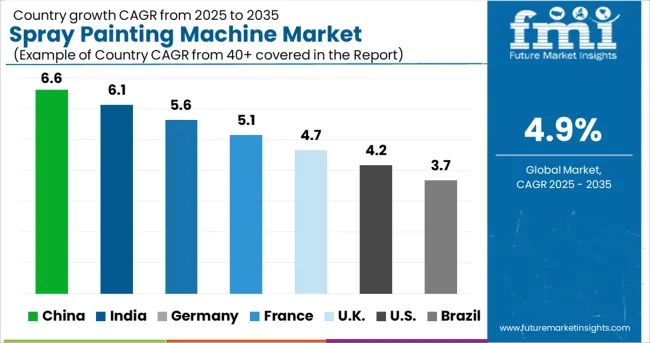
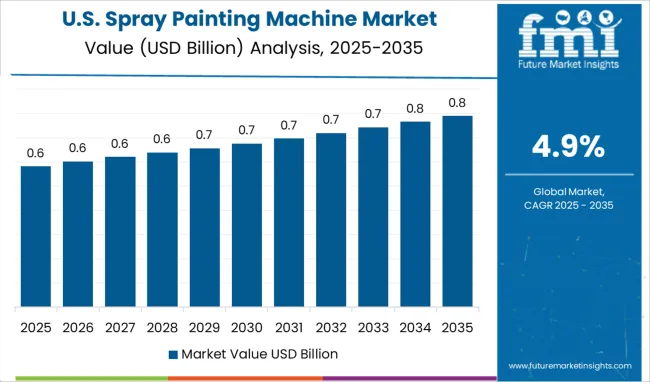
North America holds the largest share of the spray painting machine market which is attributed to the popular trend of do-it-yourself (DIY) activities for vehicle refurbishing activities and household purposes, along with the presence of major manufacturers. Moreover, there is a growing demand for customized vehicles in the region that involve the use of these paints to provide the desired aesthetic look.
Key players in the USA have decades of experience in portable airless spray painting machines and have been involved in innovation to deliver the high performance and maximum productivity required to grow businesses. Furthermore, the demand for spray painting machines is rising in the country since key players offer a configuration designed to meet the needs of small residential contractors to large contractors tackling various projects.
Market leaders in advanced paint applicators develop and market a wide array of painting and decorating products used in industrial fine finishing, home improvement, and commercial painting. Furthermore, they claim that their airless spray painting machines ensure a uniform and flawless coat of paint coverage on all surfaces for both interior and exterior painting tasks.
Customers can find spray painting machines with the highest-quality parts which are further backed by the industry’s leading warranty. Moreover, these machines are 100% factory-tested and field-proven. In addition, customers can further choose from electric, gas-powered, and battery-operated spray painting machines, according to their preference. This is likely to expand the global spray painting machine market size.
Europe holds the second largest share of the spray painting machine market owing to the proliferating architectural industry which is a potential driver for the growth of the demand for spray painting machines in this region. Additionally, robust economic growth, coupled with developments in the construction sector has major implications on the market size.
There have been soaring investments in real estate coupled with favorable government policies that have propelled the growth of the industry. Furthermore, new constructions have paved the way for the paint & coating market owing to the gateway opened by the European Central Bank’s ultra-low interest rates. These factors are estimated to surge the demand for spray painting machines.
Key players in the United Kingdom are offering high-efficiency airless spray painting machines for use with oil and water-based paints, varnishes, stains, and wood preservatives. Moreover, they are equipped with 360° spray orientation which allows for use on a multitude of projects, including hard-to-reach areas. In addition, they have adjustable flow rates and adequate spray pressure that allow precise regulation of the paint flow according to the task.
Germany is a remunerative spray painting machine market which is attributed to the presence of key manufacturers who are based in Germany and have their main production facilities in the country. Additionally, the market is competitive since the prices of these machines are kept low without compromising on their quality. Moreover, customers can choose from simple hand-held models to complex robotic systems.
German market players have generated innovative strategies for centuries for spray painting machines, individual components, and complete systems to coat surfaces and apply materials. Furthermore, they produce compact spray machines that are ideal for small work, and their wide range allows one to perform continuous work. In addition, they come equipped with special nozzles (SR) that are suitable for spot repairs on vehicles.
High precision application on these spray painting machines provides the perfect finishing touch to bases of color. Additionally, the machine body is refined with a chrome surface that is resistant to corrosion. Moreover, key players offer fast shipping, specialized advice catered to the end user’s specific requirements, as well as secure payments. These factors are expected to increase the sales of spray painting machines in this country.
India is a growing spray painting machine market owing to the significant growth of several industries such as automotive, construction, and electrical & electronics. Furthermore, the growth of the decorative segment and rapid expansion of end-use industries, reduction in brush repainting, a boost in housing schemes, and rising disposable incomes collectively contribute to the global market growth. Market players provide entry-level equipment for small projects to heavy-duty paint sprayers for large commercial applications.
Spray painting machines that are available in the Indian market are supplied with new air cap designs with increased pattern shape stability, which improves automatization and decreases blotching and mottling. Moreover, they are also equipped with an ergonomic grip for comfortable use that can also work at different pressures. They further provide smooth and precise airflow control. These factors are anticipated to surge the adoption of spray painting machines.
Key market players in the country offer a wide range of products, such as airless painting machine r470, putty spray machine, electric pressure washers, airless paint sprayers r450, wall sprayer machine, and road line marking machine. Additionally, manufacturers have consistently offered quality-approved spray painting machines to their customers in order to maintain the quality-conscious image of their brand in the industry.
Start-up companies are contributing to the spray painting machine market growth by integrating advanced technologies such as artificial intelligence (AI), the Internet of Things (IoT), robotics, etc.:
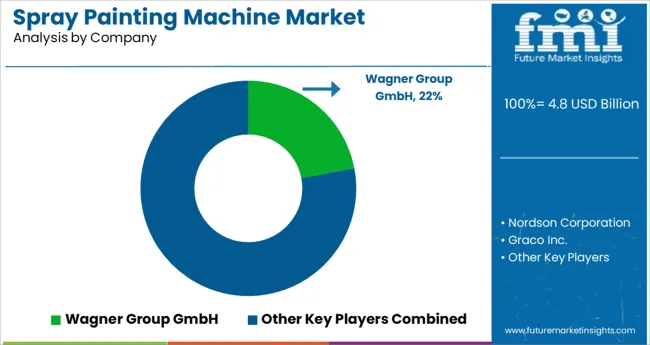
The global market for spray painting machines is growing at a rapid pace. Key players in the market are investing heavily in research and development to gain a competitive edge. The market is highly fragmented with a large number of small and medium-sized manufacturers.
| Attributes | Details |
|---|---|
| Forecast Period | 2025 to 2035 |
| Historical Data Available for | 2020 to 2025 |
| Market Analysis | million for Value and Units for Volume |
| Key Regions Covered | North America; Latin America; Europe; Asia Pacific; Oceania; Middle East and Africa (MEA) |
| Key Countries Covered | USA, Canada, Mexico, Germany, United Kingdom, France, Italy, Spain, China, Japan, India, South Korea, Australia, Brazil, Argentina, South Africa, UAE |
| Key Segments Covered | Type, Application, Region |
| Key Companies Profiled | Wagner Group GmbH; Nordson Corporation; Graco Inc.; Kremlin Rexson S.A.S.; SAMES KREMLIN; IWAI; ANEST IWATA Corporation; SATA GmbH & Co. KG. |
| Report Coverage | Market Forecast, Company Share Analysis, Competitive Landscape, DROT Analysis, Market Dynamics and Challenges, and Strategic Growth Initiatives |
| Customization & Pricing | Available upon Request |
The global spray painting machine market is estimated to be valued at USD 4.8 billion in 2025.
It is projected to reach USD 7.7 billion by 2035.
The market is expected to grow at a 4.9% CAGR between 2025 and 2035.
The key product types are airless spraying machines, hvlp spraying machines and lvlp spraying.
automotive industry segment is expected to dominate with a 37.8% industry share in 2025.






Our Research Products

The "Full Research Suite" delivers actionable market intel, deep dives on markets or technologies, so clients act faster, cut risk, and unlock growth.

The Leaderboard benchmarks and ranks top vendors, classifying them as Established Leaders, Leading Challengers, or Disruptors & Challengers.

Locates where complements amplify value and substitutes erode it, forecasting net impact by horizon

We deliver granular, decision-grade intel: market sizing, 5-year forecasts, pricing, adoption, usage, revenue, and operational KPIs—plus competitor tracking, regulation, and value chains—across 60 countries broadly.

Spot the shifts before they hit your P&L. We track inflection points, adoption curves, pricing moves, and ecosystem plays to show where demand is heading, why it is changing, and what to do next across high-growth markets and disruptive tech

Real-time reads of user behavior. We track shifting priorities, perceptions of today’s and next-gen services, and provider experience, then pace how fast tech moves from trial to adoption, blending buyer, consumer, and channel inputs with social signals (#WhySwitch, #UX).

Partner with our analyst team to build a custom report designed around your business priorities. From analysing market trends to assessing competitors or crafting bespoke datasets, we tailor insights to your needs.
Supplier Intelligence
Discovery & Profiling
Capacity & Footprint
Performance & Risk
Compliance & Governance
Commercial Readiness
Who Supplies Whom
Scorecards & Shortlists
Playbooks & Docs
Category Intelligence
Definition & Scope
Demand & Use Cases
Cost Drivers
Market Structure
Supply Chain Map
Trade & Policy
Operating Norms
Deliverables
Buyer Intelligence
Account Basics
Spend & Scope
Procurement Model
Vendor Requirements
Terms & Policies
Entry Strategy
Pain Points & Triggers
Outputs
Pricing Analysis
Benchmarks
Trends
Should-Cost
Indexation
Landed Cost
Commercial Terms
Deliverables
Brand Analysis
Positioning & Value Prop
Share & Presence
Customer Evidence
Go-to-Market
Digital & Reputation
Compliance & Trust
KPIs & Gaps
Outputs
Full Research Suite comprises of:
Market outlook & trends analysis
Interviews & case studies
Strategic recommendations
Vendor profiles & capabilities analysis
5-year forecasts
8 regions and 60+ country-level data splits
Market segment data splits
12 months of continuous data updates
DELIVERED AS:
PDF EXCEL ONLINE
Spray-dried Animal Plasma (SDAP) Market Size and Share Forecast Outlook 2025 to 2035
Spray Polyurethane Foam Market Size and Share Forecast Outlook 2025 to 2035
Spray Adhesives Market Size and Share Forecast Outlook 2025 to 2035
Spray Caps Market Size and Share Forecast Outlook 2025 to 2035
Spray Booth Ventilation System Market Size and Share Forecast Outlook 2025 to 2035
Spray Covers Market Size and Share Forecast Outlook 2025 to 2035
Spray Dried Food Market Analysis - Size, Share, and Forecast Outlook 2025 to 2035
Spray Foam Insulation Market 2025 to 2035
Spray Cheese Market Analysis by Flavours, Distribution Channel and Region through 2035
Spray Dryer Market Growth – Trends & Forecast 2025-2035
Spray Nozzle Market Growth – Trends & Forecast 2024-2034
Sprayer Cap Market Growth & Trends Forecast 2024-2034
Spray Washer Market
Spray Drying Equipment Market
Mini Spray Bottles Market Size and Share Forecast Outlook 2025 to 2035
Mist Sprayer Pumps Market by Pump Type & Application Forecast 2025 to 2035
Competitive Breakdown of Mist Sprayer Pumps Providers
Nasal Sprays Market Analysis - Size, Share, and Forecast 2025 to 2035
Dermal Sprays Market Size and Share Forecast Outlook 2025 to 2035
Throat Sprays Market Analysis - Size, Share & Forecast 2025 to 2035

Thank you!
You will receive an email from our Business Development Manager. Please be sure to check your SPAM/JUNK folder too.
Chat With
MaRIA